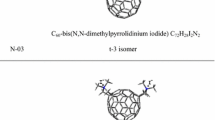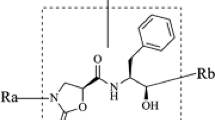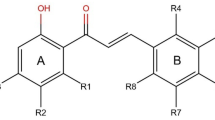Abstract
Computational prediction of HIV-1 protease inhibitor via quantitative structure–activity relationships (QSARs) is a popular study in the field of computational chemistry. The aim of the present study was building up of QSAR models for anti-HIV activity by means of the CORAL software (http://www.insilico.eu/coral). Applying of correlation weights for five and six-member molecular rings as components of the target function in the Monte Carlo optimization that is aimed to build up correlation between activity of HIV-1 protease inhibitors expressed as pIC50 = lg[1/(IC50 × 109)] and optimal descriptor improves the predictive potential. Simplified molecular input-line entry system (SMILES) is used as the representation of the molecular structure of HIV-1 protease inhibitors for the QSAR analysis. New criterion of predictive potential so-called index of ideality of correlation (IIC) has been appllied to improve the model for HIV-1 protease inhibitors activity. High correlation coefficients were observed between the experimental and predicted anti-HIV activity. Applying of special ring code as component of the Monte Carlo calculation significantly improves the statistical quality of the model. Furthermore, applying of the IIC as component of the Monte Carlo optimization improves the predictive potential of the CORAL models. The presence of the rings and the quality of these are very important molecular features which are able to improve statistical quality of model for anti-HIV activity. In addition, the ability of IIC to improve predictive potential of a model has been confirmed.


Similar content being viewed by others
References
Halder AK (2018). SAR QSAR Environ Res 29(11):911–933. https://doi.org/10.1080/1062936X.2018.1529702
Toropov AA, Toropova AP, Benfenati E, Leszczynska D, Leszczynski J (2010). J Comput Chem 31(2):381–392. https://doi.org/10.1002/jcc.21333
Toropova AP, Toropov AA, Benfenati E, Leszczynska D, Leszczynski J (2010). J Math Chem 48(4):959–987. https://doi.org/10.1007/s10910-010-9719-x
Toropova AP, Toropov AA, Veselinović JB, Miljković FN, Veselinović AM (2014). Eur J Med Chem 77:298–305. https://doi.org/10.1016/j.ejmech.2014.03.013
Toropov AA, Toropova AP, Benfenati E, Dorne JL (2018). Chem Biol Interact 290:1–5. https://doi.org/10.1016/j.cbi.2018.04.030
Toropova AP, Toropov AA, Marzo M, Escher SE, Dorne JL, Georgiadis N, Benfenati E (2018). Food Chem Toxicol 112:544–550. https://doi.org/10.1016/j.fct.2017.03.060
Lv Z, Chu Y, Wang Y (2015). HIV AIDS (Auckl) 7:95–104. https://doi.org/10.2147/HIV.S79956
Darnag R, Minaoui B, Fakir M (2017). Arab J Chem 10:S600–S608. https://doi.org/10.1016/j.arabjc.2012.10.021
OECD (2006) Report on the regulatory uses and applications in OECD member countries of (quantitative) structure-activity relationship [(Q)SAR] models in the assessment of new and existing chemicals. OECD Pap 6
Hdoufane I, Stoycheva J, Tadjer A, Villemin D, Najdoska-Bogdanov M, Bogdanov J, Cherqaoui D (2019). J Mol Struct 1193:429–443. https://doi.org/10.1016/j.molstruc.2019.05.056
Muthukumaran P, Rajiniraja M (2019). J Theor Biol 469:18–24. https://doi.org/10.1016/j.jtbi.2019.02.019
Barzegar A, Zamani-Gharehchamani E, Kadkhodaie-Ilkhchi A (2017). Future Med Chem 9(11):1175–1191. https://doi.org/10.4155/fmc-2017-0040
Sapre NS, Jain N, Gupta S, Sapre N (2013). RSC Adv 3(26):10442–10451. https://doi.org/10.1039/C3RA40685G
Fernández M, Caballero J (2006). Bioorg Med Chem 14(1):280–294. https://doi.org/10.1016/j.bmc.2005.08.022
Sapre NS, Gupta S, Pancholi N, Sapre N (2009). J Comput Chem 30(6):922–933. https://doi.org/10.1002/jcc.21114
Wei Y, Li W, Du T, Hong Z, Lin J (2019). Int J Mol Sci 20(14):3572. https://doi.org/10.3390/ijms20143572
Hdoufane I, Bjij I, Soliman M, Tadjer A, Villemin D, Bogdanov J, Cherqaoui D (2018). Pharmaceuticals 11(3):69. https://doi.org/10.3390/ph11030069
Shiri F, Pirhadi S, Rahmani A (2018). J Recept Sig Transd 38(1):37–47. https://doi.org/10.1080/10799893.2017.1414844
Bhargava S, Adhikari N, Amin SA, Das K, Gayen S, Jha T (2017). SAR QSAR Environ Res 28(12):973–990. https://doi.org/10.1080/1062936X.2017.1388281
Putz MV, Dudas NA (2013). Molecules 18(8):9061–9116. https://doi.org/10.3390/molecules18089061
Zhou Z, Lin X, Madura JD (2006). Infect Disord-Drug Targets 6(4):391–413. https://doi.org/10.2174/187152606779025833
Zhou Z, Madura JD (2004). J Chem Inf Comput Sci 44(6):2167–2178. https://doi.org/10.1021/ci049893v
Toropov AA, Toropova AP, Marzo M, Dorne JL, Georgiadis N, Benfenati E (2017). Environ Toxicol Pharmcol 53:158–163. https://doi.org/10.1016/j.etap.2017.05.011
Toropov AA, Toropova AP (2018) In: Bidoia E, Montagnolli R (eds) Toxicity and biodegradation testing. Methods in Pharmacology and Toxicology. Humana Press, New York, NY, pp 147–183. https://doi.org/10.1007/978-1-4939-7425-2_8
Toropov AA, Toropova AP, Benfenati E, Gini G, Leszczynska D, Leszczynski J (2012). Anti Cancer Agents Med Chem 12(7):807–817. https://doi.org/10.2174/187152012802650255
Velázquez-Libera JL, Caballero J, Toropova AP, Toropov AA (2019). Chemometr Intell Lab Syst 184:14–21. https://doi.org/10.1016/j.chemolab.2018.11.008
Toropov AA, Toropova AP, Benfenati E, Salmona M (2018). Toxicol Mech Methods 28(5):321–327. https://doi.org/10.1080/15376516.2017.1422579
Toropov AA, Toropova AP (2017). Mutat Res Genet Toxicol Environ Mutagen 819:31–37. https://doi.org/10.1016/j.mrgentox.2017.05.008
Toropova AP, Toropov AA (2017). Sci Total Environ 586:466–472. https://doi.org/10.1016/j.scitotenv.2017.01.198
Kumar P, Kumar A, Sindhu J (2019). SAR QSAR Environ Res 30(2):63–80. https://doi.org/10.1080/1062936X.2018.1564067
Ahmadi S (2020). Chemosphere 242:125192. https://doi.org/10.1016/j.chemosphere.2019.125192
Funding
The authors are grateful for the contribution of the project LIFE-CONCERT contract (LIFE17 GIE/IT/000461) for the financial support.
Author information
Authors and Affiliations
Contributions
Authors have done equivalent contributions to this work.
Corresponding author
Ethics declarations
Conflict of interest
On behalf of all authors, the corresponding author states that there is no conflict of interest
Additional information
Publisher’s note
Springer Nature remains neutral with regard to jurisdictional claims in published maps and institutional affiliations.
Electronic supplementary material
ESM1
(DOCX 67 kb)
Rights and permissions
About this article
Cite this article
Toropov, A.A., Toropova, A.P., Carnesecchi, E. et al. The index of ideality of correlation and the variety of molecular rings as a base to improve model of HIV-1 protease inhibitors activity. Struct Chem 31, 1441–1448 (2020). https://doi.org/10.1007/s11224-020-01525-9
Received:
Accepted:
Published:
Issue Date:
DOI: https://doi.org/10.1007/s11224-020-01525-9




